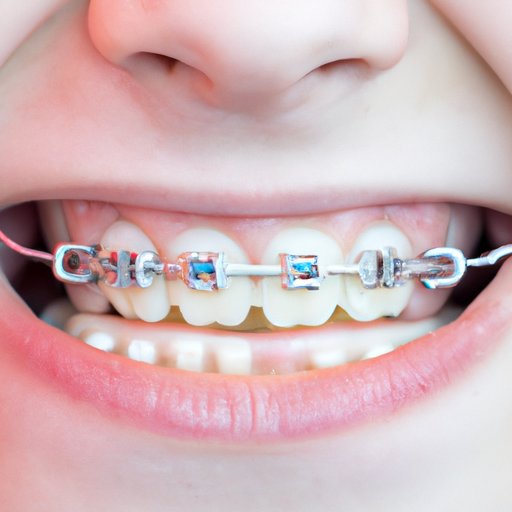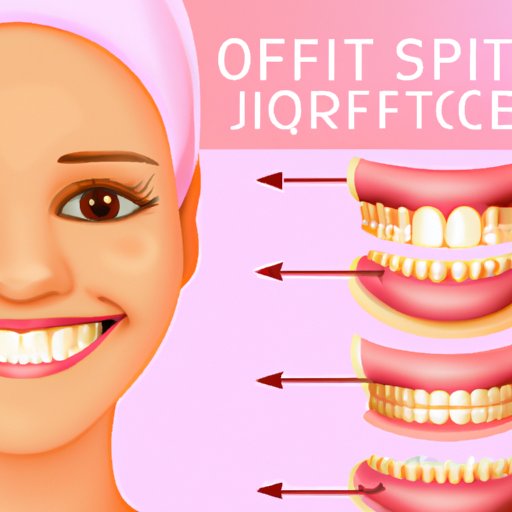
I. Introduction
Orthodontic treatment is a popular dental treatment that involves correcting misaligned teeth and jaws. It is a common solution for many dental issues, including gaps between teeth, overbites, underbites, and crowding. In this article, we will explore what exactly orthodontic treatment is, what types of treatment are available, and how it can benefit you. Whether you are seeking treatment for yourself or a loved one, read on to learn more about this popular dental solution.
II. The Basics of Orthodontic Treatment: What You Need to Know
Orthodontic treatment involves using devices like braces and clear aligners to straighten teeth that are crooked or misaligned. The goal of orthodontic treatment is to improve both your bite and your smile, which in turn can improve your confidence and oral health.
Orthodontic treatment can address many different types of dental issues, including:
- Overcrowding of teeth
- Gaps between teeth
- Overbites – When the upper front teeth stick out over the lower teeth
- Underbites – When the lower teeth stick out in front of the upper teeth
- Crossbites – When the upper teeth do not come down slightly in front of the lower teeth
When seeking orthodontic treatment, it is important to diagnose and treat the issue early on. Orthodontic treatment is most effective when it begins at a younger age, but it is never too late to start. By addressing dental issues early, you can avoid more extensive and potentially painful dental treatments later in life.
III. Straightening It Out: The Benefits of Orthodontic Treatment
One of the biggest benefits of orthodontic treatment is a beautiful, straight smile. But did you know that straight teeth can also improve your oral health?
Properly aligned teeth are easier to clean, reducing your risk of gum disease and tooth decay. When teeth are too crowded or crooked, it can be difficult to brush and floss effectively, leaving harmful bacteria that can lead to these types of dental issues. In addition, orthodontic treatment can also help correct bite issues, which can contribute to jaw pain, headaches, and difficulties with chewing and speaking. By improving your bite, orthodontic treatment can help reduce these potentially painful symptoms.
Orthodontic treatment can also boost your self-confidence and quality of life. When you feel good about your smile, you are more likely to show it off, and this can positively impact your social and professional life. Many patients report feeling more confident, comfortable, and happy with their appearance after completing orthodontic treatment.

IV. The Journey to a Perfect Smile: A Guide to Orthodontic Treatment
If you are considering orthodontic treatment, it is important to understand the steps involved. Orthodontic treatment typically involves four steps:
- Consultation – During your initial consultation, you will meet with an orthodontist to discuss your goals, dental concerns, and treatment options. This is a great time to ask any questions you may have and to get a sense of which type of treatment may be right for you.
- Evaluation – Once you have decided to move forward with treatment, your orthodontist will perform a comprehensive evaluation of your teeth and jaws. This evaluation may involve X-rays, photos, and impressions of your teeth, which will allow your orthodontist to create a customized treatment plan.
- Fitting – Once your treatment plan has been developed, you will have your braces or clear aligners fitted. This may involve cementing brackets to your teeth or fitting you with invisible aligners that can be easily removed for eating and brushing your teeth.
- Maintenance – Throughout your treatment, you will visit your orthodontist regularly for adjustments, which may involve tightening wires or switching to a new set of aligners. Your orthodontist may also advise you to wear rubber bands or headgear to help move teeth into the correct position.
It is important to choose an experienced and skilled orthodontist that you trust. Look for an orthodontist who has plenty of experience with the type of treatment you are considering, and who is willing to take the time to answer your questions and explain the process to you in detail.
Orthodontic treatment can take anywhere from several months to a few years, depending on the severity of your dental issues and the type of treatment used. If you are considering orthodontic treatment, it is best to speak with an orthodontist to get a better idea of how long your treatment may take.
V. From Braces to Invisalign: Different Types of Orthodontic Treatment
When it comes to orthodontic treatment, there are several different types of devices that your orthodontist may recommend. These include:
- Traditional braces – Made of brackets, wires, and rubber bands, traditional braces are a popular orthodontic treatment method. They are often the most effective type of treatment for severe dental issues.
- Clear braces – Clear braces are similar to traditional braces, but they use clear or tooth-colored brackets, making them less noticeable.
- Invisalign – Invisalign is a newer type of orthodontic treatment that uses clear, plastic aligners to move teeth into the correct position. They are removable and nearly invisible, which makes them a popular choice for adults.
The type of treatment that is best for you will depend on the extent and severity of your dental issues, your lifestyle, and your budget. Traditional braces are often the most effective type of orthodontic treatment, but they can be more noticeable and require more maintenance than other types of treatment. Clear braces and Invisalign are both less noticeable, but they may be more expensive and may not be as effective for severe dental issues. Your orthodontist can help you decide which type of treatment is best for you.
VI. Orthodontic Treatment for All Ages: Breaking the Stereotype
While orthodontic treatment is often associated with teenagers, it is a solution that can benefit people of all ages. In fact, one in five orthodontic patients is over the age of 18!
Orthodontic treatment for adults can help improve both oral health and self-confidence. It can correct bite issues, relieve jaw pain and headaches, and improve the appearance of your smile. Many adults report feeling more confident, comfortable, and happy with their appearance after completing orthodontic treatment.
Older adults may be concerned that orthodontic treatment will take too long or that it will be uncomfortable, but advances in technology have made orthodontic treatment faster, easier, and more comfortable than ever before. Your orthodontist can help address any concerns you may have and recommend a treatment plan that works for you.
VII. Orthodontic Treatment Myths vs. Facts: Separating Truth from Fiction
There are several myths and misconceptions about orthodontic treatment that can make people hesitant to pursue treatment. Let’s take a look at some common myths and the facts that debunk them:
- Myth: Orthodontic treatment is too expensive. Fact: While orthodontic treatment can be a significant investment, most orthodontists offer flexible payment plans and financing options to make treatment more affordable.
- Myth: Orthodontic treatment is only for teenagers. Fact: Orthodontic treatment can benefit people of all ages, from children to older adults.
- Myth: Orthodontic treatment is painful. Fact: While orthodontic treatment may cause some discomfort, advances in technology have made treatment faster, easier, and more comfortable than ever before.
- Myth: Orthodontic treatment takes too long. Fact: The length of orthodontic treatment will depend on the severity of your dental issues, but advances in technology have made treatment faster and more efficient than ever before.
- Myth: Orthodontic treatment is only for cosmetic purposes. Fact: While orthodontic treatment can improve the appearance of your smile, it also has many oral health benefits, including reducing your risk of gum disease and tooth decay.
It is important to understand the truth about orthodontic treatment and to speak with an orthodontist if you have any concerns or questions.
VIII. Conclusion
Orthodontic treatment is a popular dental solution that can improve both your smile and your oral health. Whether you are seeking treatment for yourself or a loved one, it is important to understand what orthodontic treatment is, what types of treatment are available, and the benefits it can provide. By following the steps outlined in this article and working with an experienced orthodontist, you can achieve a straighter, healthier, and more beautiful smile that will improve your confidence and quality of life.
If you are interested in pursuing orthodontic treatment, we recommend scheduling a consultation with an orthodontist in your area to discuss your options.





